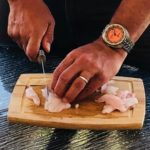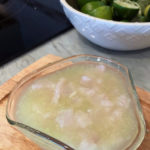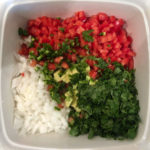One Reason I Dive
Over the years, I’ve been asked many times, “Why do you dive?”
The answer is normally, “How much time do you have?”
The answer is never simple. Sometimes I dive for adventure, sometimes it’s for time spent with my boys. Sometimes it’s for simply getting away, and sometimes it’s for putting food on the table.
To me, nothing is more enjoyable than providing for my family and me, so in this last diving excursion, I did just that. It was time to hunt.
I know there are some that don’t agree with it and if you completely swear off eating anything, but vegetable matter, I respect that.
For those who decide to eat from what the sea provides, there’s not a more responsible and sustainable way to fish than with spearfishing.
With spearfishing, you have the ability to choose.
Too small....don’t take it, too large...don’t take it.
Not the exact fish you’re looking for... don’t take it.
The power is right in your hand to choose the best fish possible. It’s a responsible and sustainable way of harvesting that no other method of fishing provides.
You might remember from the sea salt story that I visit the Florida Gulf coast as often as I can. It’s my home-away-from-home, and I enjoy spending time with my family there as much as I can. On the last visit, I called up my dive charter buddies at Emerald Coast Scuba, booked a morning dive, sharpened my spear tips, and headed out to sea.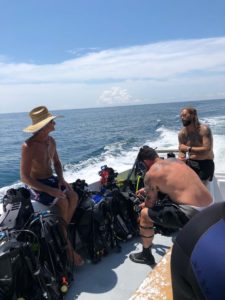
That morning it was as smooth as glass, which isn’t that common for the Gulf of Mexico. The calmness could have been attributed to a squall that recently blew in, which laid down the waves. However, a tropical storm had moved through the region a week before, stirring up the bottom a bit, but it was still prime for hunting.
The day’s quarry was lionfish. There are other fish species to hunt legally, but then again there are species that aren’t. If one isn’t well versed on legal size limits, catch limits, or legal species, the thought of legally spearing fish can be a bit daunting. A species can be legal one day, and with the closing of a season, illegal the next. It’s often difficult to judge size underwater, and a fish that looks legal on your spear can turn illegal back on the boat if you happened to misjudge by half an inch.
Lionfish are entirely different, and their pursuit is essentially mindless. Since they are a non-native, invasive species to these waters, there are no limits of any kind. Whether one is small as a thimble, or big as a football; whether you shoot one or one hundred, it’s all fair and legal game.
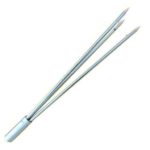
Paralyzer Spear
In my opinion, lionfish are best pursued with a pole spear, and a non-barbed, three prong spear tip called a “Paralyzer”. The paralyzer tip gives you three points of penetration ensuring a quick kill, and the tines are long enough so they hold the fish until you can safely put it in a puncture proof tube. Lionfish are equipped with venomous spines, and if not handled securely and carefully, can provide a devastating sting. This sting is so bad that it can cause major necrosis and tissue loss in the area of the sting. If one happened to be allergic to the venom, a lionfish sting could technically be fatal.
The site of the hunt was on a man-made wreck site called the “Liberty Ship”. This is a decommissioned World War II cargo ship that was stripped of all decking and superstructure and deliberately sunk to provide marine life habitat. All that’s left is the hull and bulkheads, so it’s somewhat like diving inside a 400-foot bathtub.
Once in the water, the color was green all around, with the contrast of the bright white anchor line disappearing into the depths. Not only does the anchor line keep our dive boat, the Aquanaut (which as a side note, was used in the 1978 filming of Jaws II), but it points the way to the wreck and our hunting grounds.
If you’re weighted properly, when wearing a full wetsuit, the first few feet require several kicks to start the descent. Once the pressure takes over, the suit compresses and you fall faster and faster toward the bottom. Being in close to 80 feet of water you have some time to set the dive watch bezel, position the pole spear, and clutch the power inflator. The power inflator is like the braking system on the dive rig. As you near the bottom, you give a few short bursts of air to the buoyancy wing, and you come to a slowing halt. You don’t want too much because you can reverse the motion and begin ascending. Complete neutrality is the goal, and with perfect neutrality obtained, Jason, my dive master/dive buddy, and I began to work the outside of the hull.
I was first one in and first on the bottom, so the first thing I saw lurking through the haze was the silhouette of a decently sized shark. Along with its entourage of scavenging remoras, it turned and disappeared. Based on prior experience, I knew it wasn’t gone.
Lionfish here haven’t been hunted as aggressively as other parts of the Gulf, Atlantic, and Caribbean (Grand Cayman, for example), so it only took a few seconds to have one on the spear.
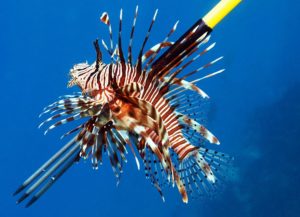
A quick shove into the rigid, lionfish-proof plastic tube, and it was time to spear another. Still working the outside of the hull, and with blood in the water, the shark that was lurking in the haze was now back and in full view. It wasn’t alone either, now there were two.
What kind of sharks were they? They could have been Duskys, or they could have been Browns, but I was more concerned about protecting the tube than shark identification. One is known to bite, the other one isn’t, so to play it safe we swam up and over to the inside of the hull where the sharks typically won’t go. They patrol the perimeter and find the inside too confining. As I dropped inside, I looked back once more to check on our toothed companions. They were staying their course, and didn’t pursue; however, a slow and clumsy 400 lb. Goliath Grouper came lumbering out to survey the scene. The grouper and the sharks are a sharp contrast in biological design, like a bulldog compared to a greyhound, but both are fascinating in their own way.
The inside proved more lucrative than the out and probing the small nooks in the hull, one fish after the other fell to the spear. Unfortunately, the lionfish far outnumbered our air supply, so with a healthy amount of fish in the tube, we headed to the surface.
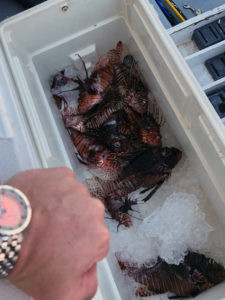 I mentioned before that the spines are venomous, so extra care is needed when handling. It’s a good idea to wear needle-proof, puncture-resistant gloves and have hot water available as hot water helps neutralize the venom. A set of surgical shears makes quick work of the spines, and then they can be filleted like any other fish. Once filleted, that’s when the goodness begins.
I mentioned before that the spines are venomous, so extra care is needed when handling. It’s a good idea to wear needle-proof, puncture-resistant gloves and have hot water available as hot water helps neutralize the venom. A set of surgical shears makes quick work of the spines, and then they can be filleted like any other fish. Once filleted, that’s when the goodness begins.
For those of you who have never eaten lionfish, it has to be one of the finest fish around for the table. The meat is light, mild, white, and flaky. The flavor is delicate, so I saw no reason to overpower it with heavy sauces or spices. For me, there’s no better way to prepare and serve it than with the citrus-cured method of ceviche. It’s simple, and with a handful of ingredients, it can even be prepared on the boat.
So you thought this post was only going to be about a spearfishing adventure?
Not hardly.
You need to know how to make the lionfish ceviche, and here’s how it goes:
Lionfish Ceviche
1 avocado
4 Roma tomatoes
1/2 onion
1 medium jalapeño
1 cup minced cilantro
Lime juice
Serve with tortilla chips, and Tostitos “Hint of Lime” chips make it even better.
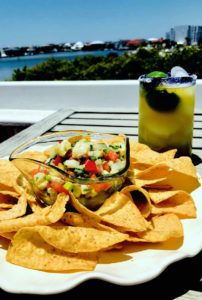
It’s good with all varieties of snapper, grouper, etc.
Now with your juicer still out, juice four to six more limes, and make a batch of fresh margaritas.
6 oz lime juice
6 oz tequila
3 oz Cointreau
3 oz simple syrup
Fine seasalt
Crushed ice
Serves about four.
If you don’t already have simple syrup in your home bar, it’s incredibly easy to make.
Yes, it’s that easy.

